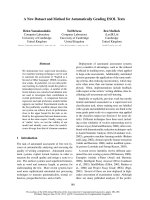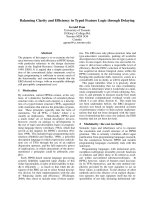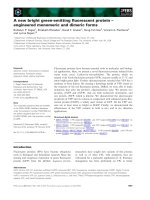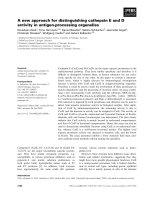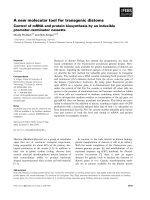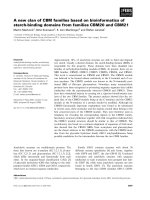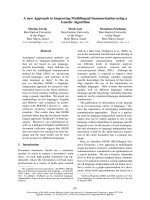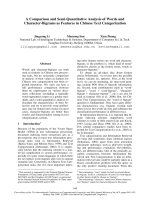Báo cáo khoa học: A new and efficient method for inhibition of RNA viruses by DNA interference pptx
Bạn đang xem bản rút gọn của tài liệu. Xem và tải ngay bản đầy đủ của tài liệu tại đây (435.39 KB, 9 trang )
A new and efficient method for inhibition of RNA viruses
by DNA interference
Monika Nowak
1
, Eliza Wyszko
1
, Agnieszka Fedoruk-Wyszomirska
1
, Henryk Pospieszny
2
,
Mirosława Z. Barciszewska
1
and Jan Barciszewski
1
1 Institute of Bioorganic Chemistry, Polish Academy of Sciences, Poznan, Poland
2 Department of Virology and Bacteriology, Institute of Plant Protection, Poznan, Poland
Introduction
RNA technologies, which began 30 years ago with
the antisense oligonucleotides, and progressed through
ribozymes and DNAzymes (deoxyribozymes) and
their analogues, have not met expectations, as they
have failed to deliver a suitable agent that can effec-
tively inhibit gene expression at the RNA level. RNA
interference (RNAi) technology is the most recent in
the long line of nucleic acid-based therapeutic candi-
dates. RNAi is induced by long dsRNA processed by
the endonuclease Dicer into 21 nucleotide short inter-
fering RNAs (siRNAs) or other 19–28 nucleotide
small RNAs (sRNAs) [1,2]. These short stretches of
RNA with 3¢-overhangs of two nucleotides are incor-
porated into RNA-induced silencing complex (RISC),
where they unwind, and an antisense strand of siR-
NA (guide strand) then binds to the complementary
RNA. A target RNA molecule undergoes endonucleo-
lytic cleavage or, optionally, translational repression
is achieved. After identification of the chemically syn-
thesized siRNAs as sufficient effectors for RNAi [3,4],
studies focused on the development of siRNAs with
improved stability, pharmacokinetic properties and
pharmacodynamic properties that were suitable for
in vivo applications. Chemical modifications of siRNA
include protection of internucleotide phosphodi-
ester bonds, ribose residues and nucleobases, and
Keywords
Dicer; DNA interference; gene silencing;
RNA interference; siDNA
Correspondence
J. Barciszewski, Institute of Bioorganic
Chemistry of the Polish Academy of
Sciences, Noskowskiego 12, 61-704
Poznan, Poland
Fax. +48 61 8520532
Tel: +48 61 8528503
E-mail:
(Received 16 February 2009, revised 2 June
2009, accepted 10 June 2009)
doi:10.1111/j.1742-4658.2009.07145.x
We report here a new method for inhibition of RNA viruses induced by
dsDNA. We demonstrated that both long dsDNA molecules and short
interfering DNA with a sequence complementary to that of viral RNA
inhibited tobacco mosaic virus expression and prevented virus spread. Also,
the expression of the HIV-1 gp41 gene in HeLa cells was inhibited by com-
plementary short interfering DNA. We showed that Dicer processed
dsDNA, which suggests activation of the cellular machinery involved in
silencing of RNA. For the silencing of viral RNA effected with dsDNA,
we coined the term DNA interference technology.
Abbreviations
Ago, Argonaute; as-DNA, short antisense ssDNA; DNAi, DNA interference; GAPDH, glyceraldehyde-3-phosphate dehydrogenase; HIV-1, human
immunodeficiency virus type 1; ODN, oligodeoxynucleotide; PMMoV, pepper mild mottle virus; RHA, RNA helicase A; RISC, RNA-induced
silencing complex; RNAi, RNA interference; s-DNA, short sense ssDNA; siDNA, short interfering DNA; siRNA, short interfering RNA; sRNA,
small RNA; TMV, tobacco mosaic virus.
4372 FEBS Journal 276 (2009) 4372–4380 ª 2009 The Authors Journal compilation ª 2009 FEBS
attachment of different tags on either the 5¢-end or
the 3¢-end [5].
Despite common features of RNA silencing, there
are differences between the animal and plant king-
doms. The mechanism of RNA silencing in plants is
often known as post-transcriptional gene silencing.
Various classes of sRNAs, ranging from 18 to 26
nucleotides, can be found, as well as different forms of
Dicer. For example, in Arabidopsis thaliana, dsRNA is
processed into sRNA duplexes of specific sizes by one
of four Dicer-like proteins [6]. Furthermore, plant
RNA silencing can spread from an initially silenced
cell to surrounding cells (short-range spread through
the plasmodesmata) and over a long distance through
the vascular system to different parts of the plant [7,8].
Double-stranded RNAs, which induce RNA silenc-
ing, might be derived from virus replication, transcrip-
tion, inverted-repeat sequences, or convergent
transcripts, or may also be generated endogenously
within the cell, e.g. as a transcript with an internal
stem–loop structure [6]. Alternatively, dsRNA may be
synthesized by one of six RNA-dependent RNA
polymerases, which copy antisense RNA from an aber-
rant or overexpressed sense transcript. Such RNA-
dependent RNA polymerases may also participate in
the spread of silencing signals by amplification of
dsRNAs. Such a mechanism has been identified in
fungi, worms, and plants [1].
Dicer and Dicer-like proteins are approximately
200 kDa multidomain members of the RNase III fam-
ily that are responsible for processing long dsRNAs
into effector siRNAs. Human Dicer contains a single
PAZ domain, a single dsRNA-binding domain, and
ATPase ⁄ helicase domains, as well as two RNase III-
like domains and a domain of unknown function
(DUF238) [9]. Dicer appears to be a complex and
dynamic enzyme that interacts with other cellular pro-
teins. In mammalian cells, Dicer is associated with
TAR-RNA-binding protein [10] and Argonaute (Ago)
proteins [11]. It is thought that Dicer–Ago protein
complex formation is crucial for siRNA channelling
into RISC and mediating the transition between the
initiation and execution phases of RNAi. Ago proteins
are key components of RISC responsible for the cleav-
age of the target RNA. The cleavage is catalysed by a
Piwi domain of Ago proteins, the structural homolog
of RNase H [12,13]. Both Dicer and Ago proteins con-
tain PAZ domains, which recognize and bind to the
ends of dsRNA molecules [14].
In a previous article, we described the viral RNA
degradation induced by a short (16 nucleotide) ssRNA
that binds to tobacco mosaic virus (TMV) RNA,
forms the leadzyme structure and, in the presence of
lead ions, causes the cleavage of virus genomic RNA
[15]. Here, we extend our studies by analysing the
antiviral effects of short and long DNA and RNA
molecules specific for TMV genomic RNA. We have
found that both long dsRNA and long dsDNA are
potent inhibitors of viral RNA. A long dsDNA frag-
ment (470 bp) that is homologous with TMV RNA
suppressed TMV infectivity in Nicotiana tabacum.We
also demonstrated that siDNAs are capable of
sequence-specific inhibition of viral RNA both in
tobacco plants and in HeLa cells. Furthermore, Dicer
has been shown to be capable of DNA cleavage, which
suggests that the silencing of viral RNA was due to a
mechanism analogous to RNAi, which we have called
DNA interference (DNAi).
Results and discussion
The dsDNA (470 bp) and ssDNAs, with either sense
or antisense orientation, were tested for their ability to
inhibit the development of local lesions elicited by
TMV in N. tabacum cv. Xanti-nc. Half-leaves were
inoculated with the virus supplemented with one of the
following: sense strand DNA, antisense strand DNA,
dsDNA, or TMV-specific siRNA. Five experiments
were performed, comprising several assays: (a) plants
inoculated with only TMV; (b) plants inoculated with
TMV and long dsDNAs; (c) plants inoculated with
TMV and siRNA; (d) plants inoculated with short
antisense ssDNA (as-DNA); (e) plants inoculated with
TMV and short sense ssDNA (s-DNA); and (f) unin-
oculated control tobacco (Table 1). For each single
assay, three to five plants were inoculated with the
same inoculum. All tested DNAs as well as siRNA
were homologous to the region including nucleotides
203–674 of TMV RNA within the first ORF encoding
replicase [15]. The necrosis lesions caused by TMV
spread were monitored 5 days postinfection. Reduced
infectivity was observed in tobacco leaves inoculated
with long dsDNA (at 330 nm) or siRNA. It was mani-
fested as a decreased number of local lesions (necrotic
symptoms) when compared with control plants treated
only with TMV (Fig. 1A,B). Neither sense nor anti-
sense DNA strands alone affected local lesion forma-
tion by TMV. These macroscopic observations were
confirmed with RT-PCR analysis (Fig. 1C), which
showed a lack of TMV RNA accumulation in tobacco
plants treated either with dsDNA or with siRNA
homologous to a part of the TMV RNA (Fig. 1C,
lanes 5 and 6), in contrast to infected leaves treated
with sense and antisense DNAs (Fig. 1C, lanes 3 and
4) as well as TMV alone (lane 2). The level of glyceral-
dehyde-3-phosphate dehydrogenase (GAPDH) mRNA
M. Nowak et al. Virus inhibition by DNA interference
FEBS Journal 276 (2009) 4372–4380 ª 2009 The Authors Journal compilation ª 2009 FEBS 4373
used as a control was similar in all samples. In a previ-
ous study of Tenllado and Diaz-Ruiz [16], it was
shown that long dsRNA (977 bp) but not cDNA
(1409 bp) with the sequence corresponding to part of
the replicase gene reduced the infectivity of pepper
mild mottle virus (PMMoV) in a Nicotiana benthami-
ana host. Although the authors did not observe reduc-
tions of PMMoV expression in tobacco plants in
response to cDNA treatment, northern blot analysis
showed lower intensities of the virus RNA band in
extracts prepared from leaves inoculated with cDNA
in comparison with control leaves inoculated only with
the virus and sense or antisense long RNAs. The effect
of PMMoV inhibition by treatment with cDNA was
visible as a weaker northern blot signal in leaves inoc-
ulated with specific nucleic acids, but was not
observable in the uppermost systemic leaves of
N. benthamiana. The weaker response of infected
tobacco plants to dsDNA treatment in these experi-
ments could be explained by the length of the cDNA
(1409 bp), which was longer than that of the dsRNA
and dsDNA used in our experiments (470 bp). Such
long molecules probably had a limited ability to enter
the cell.
To further characterize the antiviral effect of specific
nucleic acids, we prepared anti-TMV long dsRNA
(280 bp) and short interfering DNA (siDNA, 21 bp),
as well as long, scrambled, nonspecific dsDNA
(384 bp) (Table 1). All anti-TMV nucleic acids used
were located within 203–674 nucleotides of TMV
RNA, as in the previous experiments. Whereas the
scrambled dsDNA did not influence viral expression,
both dsRNA and siDNA reduced TMV accumulation
in tobacco plants (Fig. 1D,E). This was also observed
in RT-PCR analysis (Fig. 1F). The level of viral RNA
inhibition induced by long dsRNA was greater than in
the case of siDNA, but comparable with the long
dsDNA effect. Silencing of viral RNA was observed to
be most efficient in cases of long dsRNA (89%), long
dsDNA (84%), and siRNA (89%), and less efficient
for siDNA (70%), whereas long scrambled dsDNA
and short antisense and sense ssDNAs had no effect
on viral expression (Table 1).
It was not surprising that siRNA and long dsRNA
were potent silencers of specific RNA, but the fact that
both long and short dsDNAs showed similar effects is
intriguing. To determine whether such a dsDNA-
induced silencing effect on RNA could be observed in
cultured human cells, we analysed the influence of siD-
NAs on HIV-1 gp41 RNA expression in HeLa cells.
The cells were cotransfected with the pEGFP-N3-
gp41-323 vector encoding a gp41 protein and siDNA
at 10, 25, 50, 100 and 250 nm, respectively. Cells with
green fluorescence expressed the gp41–EGFP fusion
protein. After treating the cells with increasing concen-
trations of siDNA, we observed a decrease in the
expression of gp41 (Fig. 2A). In order to prove that
the silencing effect was due to degradation of the tar-
geted gp41 RNA, we carried out RT-PCR analysis
and found degradation of gp41–EGFP RNA in the
presence of siDNA (Fig. 2B). The semiquantitative
analysis showed decreases of approximately 50% and
78% in the expression level of gp41 when 25 nm and
100 nm siDNA was applied, respectively (Fig. 2C). In
a analogous experiment on HeLa cells transfected with
siRNA with a sequence identical to that of siDNA, we
observed a strong decline in viral expression when
cells were treated with 5 nm siRNA (84%) (Fig. 2D–
F). Scrambled siRNA did not affect gp41–EGFP
expression (data not shown). Therefore, we can con-
Table 1. Comparison of RNA and DNA silencing triggers. The effectiveness of specific DNA and RNA molecules in silencing TMV or gp41
expression was evaluated as an average percentage of TMV or gp41 reduction on the basis of a number of local lesions in infected tobacco
plants (Fig. 1) and semiquantitative
IMAGEQUANT analysis of RT-PCR results (Fig. 2), respectively. Silencing effects were evaluated for specific
DNA and RNA concentrations as shown.
Type of nucleic acid Length Target
Localization of target
sites (nucleotides)
Silencing effect
%nM
dsDNA 470 bp TMV RNA 203–674 of TMV RNA 84 330
as-DNA (ssDNA) 22 nucleotides TMV RNA 483–504 0 5 · 10
3
s-DNA (ssDNA) 20 nucleotides TMV RNA 390–409 0 5 · 10
3
siRNA 21 bp TMV RNA 420–440 89 4.5 · 10
3
dsRNA 284 bp TMV RNA 390–674 89 330
siDNA 21 bp TMV RNA 549–569 70 4.5 · 10
3
Scrambled dsDNA 384 bp TMV RNA Non-TMV 0 330
siRNA 21 bp HIV1gp41 257–277 of gp41 RNA 96 100
siDNA 21 bp RNA 257–277 78 100
Virus inhibition by DNA interference M. Nowak et al.
4374 FEBS Journal 276 (2009) 4372–4380 ª 2009 The Authors Journal compilation ª 2009 FEBS
clude that siDNAs are less potent inhibitors of specific
RNAs in cultured human cells than are siRNAs. The
same effect was observed in a tobacco plant model
(Fig. 1). The ability of siDNA molecules to specifically
inhibit gene expression has been demonstrated before
in mammalian cell culture [17].
Our findings clearly demonstrate that both exoge-
nous long dsDNA and siDNA molecules can be
applied for silencing of homologous RNA. To deter-
mine the mechanism of this process, we tested dsDNA
processing in plant extract. Products of 20–26 bp were
observed (Fig. 3A), suggesting the involvement of
Dicer in dsDNA processing. Interestingly, dsDNA
(160 bp) incubated with Dicer also gave short dsDNA
fragments of 21–30 bp, with the most abundant being
17 bp (Fig. 3B, lane 3). Incubation with smaller
amounts of the enzyme provided intermediate products
of dsDNA hydrolysis (Fig. 3B, lane 2). We also
A
B
C
E
F
D
Fig. 1. Inhibition of TMV infection in N. tabacum cv. Xanti-nc leaves with various nucleic acid-based effectors complementary to the repli-
case gene of TMV RNA. (A) Half-leaves were inoculated with TMV and either 22 nucleotide sense strand DNA, 20 nucleotide antisense
strand DNA, 470 bp dsDNA, or siRNA. Tobacco leaves with symptoms of TMV infection are shown. Uninfected plants and plants inoculated
only with the virus were used as controls. Leaves were photographed at 5 days postinoculation. (B) Diagram showing changes in local
lesions observed on tobacco leaves after inoculation of virus with TMV-specific as-DNA, s-DNA, dsDNA, and siRNA. Data (±standard devia-
tion) from three independent experiments are shown. (C) Analysis of RT-PCR products for TMV and GAPDH on 1.5% agarose gel. The reac-
tion products were amplified from total RNA extracted from the infected tobaco leaves and uninfected control. TMV cDNA (470 bp) was
amplified with primers corresponding to the 203–674 fragment of TMV RNA. GAPDH cDNA (300 bp) amplified with primers specific for
tobacco GAPDH was used as a reference. (D) Half-leaves of tobacco leaves were inoculated with TMV alone, TMV and scrambled dsDNA
(384 bp), TMV and siDNA, and TMV and dsRNA (280 bp). Symptoms of infection are shown. (E) Graph showing the amounts of necrotic
symptoms observed on tobacco leaves after inoculation of virus with scrambled dsDNA and TMV-specific siDNA or dsRNA. Data (±standard
deviation) from three independent experiments are shown. (F) Analysis of RT-PCR products for TMV and GAPDH on 1.5% agarose gel. The
reaction products were amplified from total RNA extracted from tobaco leaves inoculated with TMV and scrambled dsDNA, TMV-specific
siDNA, and dsRNA.
M. Nowak et al. Virus inhibition by DNA interference
FEBS Journal 276 (2009) 4372–4380 ª 2009 The Authors Journal compilation ª 2009 FEBS 4375
observed some nonspecific degradation of a substrate
DNA of 9–10 nucleotides. From these results, it is
clear that Dicer shows a broad nuclease specificity with
the potential to cleave dsDNA substrates, like other
enzymes, e.g. S1 and Neurospora crassa nucleases,
which efficiently process both DNA and RNA [18,19].
The ability of proteins with PAZ domains to bind
DNA has been confirmed in crystallographic studies
A
B
C
D
E
F
Fig. 2. RT-PCR analysis of HIV-1 gp41 mRNA expression in HeLa cells transfected with gp41-specific siDNA or siRNA. (A) Fluorescence
microscopy of HeLa cells expressing gp41–EGFP protein. Cells were cotransfected with pEGFP-N3-323 and anti-gp41 siDNA at the concen-
trations indicated, and harvested after 24 h for total RNA isolation. (B) RT-PCR amplification products of total RNA from HeLa cells transfect-
ed as indicated. Products were fractioned by electrophoresis on 1.5% agarose gel with ethidium bromide. (C) Diagram showing an
evaluation of gp41 mRNA inhibition with siDNA in HeLa cells. Numbers below the diagram represent concentrations of anti-gp41 siDNA (10,
25, 50, 100 and 250 n
M, respectively) cotransfected with 1 lg of pEGFP-N3-323. The analysis was performed using IMAGEQUANT (Molecular
Dynamics). Data are represented as mean ± standard deviation. (D) HeLa cells expressing gp41–EGFP protein after transfection with anti-
gp41 siRNA. (E) RT-PCR analysis of gp41 and GAPDH from HeLa cells transfected with siRNA as indicated. (F) Graph showing semiquantita-
tive analysis of gp41 mRNA expression in HeLa cells transfected with siRNA.
Virus inhibition by DNA interference M. Nowak et al.
4376 FEBS Journal 276 (2009) 4372–4380 ª 2009 The Authors Journal compilation ª 2009 FEBS
on PAZ domains of Ago proteins from Drosophila
[14,20,21]. Thus, we can assume that the PAZ domain
is able to recognize RNA as well as DNA and there-
fore directs the cell protein machinery for RNA
interference or, alternatively, DNAi pathway. Post-
transcriptional gene silencing induced by dsDNA has
been observed previously in Nicotiana species [22,23]
and ferns [24,25]. Our hypothesis that DNAi, like
RNAi, acts at the RNA level is consistent with the
previous observation that long dsDNAs with sequences
homologous to those of the targeted RNAs caused
knockout phenotypes in Adiantum gametophytes, and
the lack of a silencing effect when dsDNA corre-
sponded to the intron sequence of the target gene [24].
Hydrolysis of dsDNA with Dicer makes it possible
to channel the siDNA molecules into RISC by the
action of Ago protein. Recently, RNA helicase A
(RHA) was identified as a human RISC-associated fac-
tor contributing to loading and unwinding of siRNA
[26]. It has been shown that RHA unwinds RNAÆRNA
duplexes as well as RNAÆDNA heteroduplexes. It also
shows an affinity for ssDNA [27]. Thus, we cannot
exclude the involvement of RHA in siDNA processing
or the existence of an equivalent DNA helicase. The
unwound antisense strand of siDNA binds a homolo-
gous target RNA, and such a complex is cleaved by
the Piwi domain of Ago protein. Because Piwi is the
structural homologue of RNase H [12,13], the siDNA
antisense strand–target RNA complex can be effi-
ciently hydrolysed. Recently, the crystal structure of
eubacterial Thermus thermophilus Ago protein com-
plexed with 21 nucleotide guide DNA and its 20 nucle-
otide target RNA was reported [28,29]. In the cleavage
activity assays, it was shown that Ago protein com-
plexed with the DNA guide strand efficiently bound
and cleaved the target RNA, even when single muta-
tion in the target RNA was introduced [28]. The cleav-
age rate was reduced after insertion of a dual bulge at
the same position on the target RNA.
It seems that siDNA works in a similar way as
siRNA, simply because DNA resembles a modified
siRNA molecule deprived of the 2¢-OH group of
ribose. We showed the silencing effect of targeted
RNA in HeLa cells to be at the level of approximately
78% when 100 nm siDNA was used (Fig. 2). Applica-
tion of higher concentrations of siDNAs than of
siRNAs is necessitated by the lower stability of
RNAÆDNA than of RNAÆRNA duplexes formed
within RISC. On the other hand, DNA oligomers are
more resistant to intracellular nucleases than oligoribo-
nucleotides, and they do not need to be modified. A
different mechanism has been proposed for oligode-
oxynucleotides (ODNs), which efficiently reduced
retroviral replication both in human cell culture and a
mouse model [30,31]. The ODNs (54 nucleotides) were
designed to form hairpin–loop-structured DNA, which
binds viral RNA and forms a triple helix. The authors
suggested that the antiviral effect of the examined
ODNs was due to the action of viral RNase H.
In summary, our data suggest that the DNAi path-
way may have converging steps with RNAi, or exploit
the RNAi protein machinery. There are some features
of DNAi that resemble RNAi, e.g. sequence-specific
inhibition of targeted RNA, processing of long
dsDNA molecules to shorter triggers, and the potential
of siDNA to induce silencing. Although dsDNA cleav-
age induced by Dicer is slightly less efficient than in
the case of dsRNA, and a higher dose of siDNA is
required for efficient silencing, dsDNA shows higher
cellular stability than dsRNA. The other advantages of
AB
Fig. 3. Hydrolysis of dsDNA in tobacco leaf extract and in vitro
with Dicer. (A) Autoradiogram of 10% polyacrylamide gel with 7
M
urea of a
32
P-labelled dsDNA (470 bp) cleavage products. Incubation
of DNA in plant extract was carried out at 25 °C, and 10 lL por-
tions of the incubated mixture were removed at the following
times: 0 min (lane 1), 2 min (lane 2), 5 min (lane 3), 15 min (lane 4),
30 min (lane 5), 1 h (lane 6), 2 h (lane 7), 5 h (lane 8), 8 h (lane 9),
and 24 h (lane 10). For cleavage product evaluation, a DNA size
marker of 29 nucleotides was used. (B) In vitro hydrolysis of
dsDNA with Dicer. Autoradiogram of 10% polyacrylamide gel with
7
M urea of c
32
P-labelled dsDNA (160 bp) incubated with human
recombinant Dicer (Ambion). Lane 1: control DNA incubated in 1·
Dicer reaction buffer (Ambion). Lane 2: DNA with 1 U of Dicer.
Lane 3: DNA with 3 U of Dicer. A 29 nucleotide DNA size marker
(M) was used for product determination.
M. Nowak et al. Virus inhibition by DNA interference
FEBS Journal 276 (2009) 4372–4380 ª 2009 The Authors Journal compilation ª 2009 FEBS 4377
DNAi are the lower cost of dsDNA synthesis and the
lack of necessity for further DNA modification. These
observations may open a new path towards the use of
dsDNA or siDNAs as reverse genetics and therapeutic
tools in mammalian cells and plant models.
Experimental procedures
Inoculation of tobacco leaves
Before inoculation, carborundum was sprayed onto leaves
of N. tabacum cv. Xanti-nc plants. Inoculations were car-
ried out on one-half of a fully expanded leaf of at least
three tobacco plants for one assay by gently rubbing the
leaf surface with the inoculum. The opposite half of the leaf
served as an uninoculated control. All leaves chosen for
inoculation were at the same developmental stage. The
inoculum used throughout experiments contained TMV
suspension (strain U1 at 5 lgÆmL
)1
) mixed immediately
before inoculation with either dsDNA corresponding to
TMV RNA (470 bp, at concentrations ranging from 65 to
330 nm), ssDNA (as-DNA of 22 nucleotides and s-DNA of
20 nucleotides at 5 lm), siRNA (4.5 lm), siDNA (4.5 lm),
dsRNA (284 bp, 330 nm), or scrambled dsDNA (384 bp,
330 nm). After infection, the inoculated plants were kept in
a growth chamber, initially at 20 °C temperature (first day),
and then at 25 °C with 12 h light and 12 h dark cycle.
Silencing of TMV RNA was monitored by the observation
of local lesion formation. Inoculated leaves were harvested
and photographed 5 days postinoculation.
Double-stranded DNA (470 bp) corresponding to TMV
genomic RNA nucleotides 203–674 (RNA fragment-encod-
ing replicase gene) was synthesized on the TMV RNA tem-
plates isolated from the infected tobacco leaves by
RT-PCR, using primers TMV1 (5¢-GCCCAAGGTGAACT
TTTCAA-3¢) and TMV2 (5¢-TAGCGCAATGGCATACA
CTC-3¢). The sequence of as-DNA is 5¢-CAATACTGTCT
TTCTGGCCTTC-3¢, and that of s-DNA is 5¢-ATAGGCG
GGAATTTTGCATC-3¢. Anti-TMV siRNA was synthe-
sized using the DNA templates 5¢-AAGGGACGAGCA
TATGTACACCCTGTCTC-3¢ and 5¢-AAGTGTACATAT
GCTCGTCCCCCTGTCTC-3¢ and a Silencer siRNA Con-
struction Kit (Ambion, Austin, TX, USA). The sequence of
the anti-TMV siDNA sequence sense strand is 5¢-
AACTTCCAAAAGGAAGCATTT-3¢, and that of the
antisense strand is 5¢-ATGCTTCCTTTTGGAAGTTTT-3¢.
Specific anti-TMV dsRNA (284 bp) was obtained by T3
and T7 in vitro transcription (MEGAscript T3 High Yield
Transcription Kit, MEGAscript T7 High Yield Transcrip-
tion Kit; Ambion) and hybridization of the obtained RNA
strands. The templates for the T3 and T7 transcriptions
were prepared by RT-PCR with primers containing pro-
moters for T3 and T7 RNA polymerases, respectively. The
characteristics of all DNA and RNA molecules (both with
target sites for specific RNA DNA binding) used in the
experiments are shown in Table 1. All ODNs were pur-
chased from IBB (Warsaw, Poland).
RNA analysis
Total RNA was extracted from inoculated leaves at 5 days
postinoculation, as described previously [15]. TMV RNA
was detected by RT-PCR using the TMV-specific primers
TMV1 and TMV2. Reverse transcription and PCRs were
performed as described previously [15]. The specific primers
used for detection of tobacco GAPDH were GAPDH_t1
(5¢-TGGAAGAATTGGGCGATTAG-3¢) and GAPDH_t2
(5¢-GCAGCCTTGTCCTTGTCAGT-3¢). The gp41-specific
primers were gp41-A (5¢-CCAAGGCAAAGAGAAGAGT
GG-3¢) and gp41-B (5¢-CTCCATCCAGGTCGTGTG
A-3¢); the human GAPDH-specific primers were G1
(5¢-GGGTGGAGCCAAACGGGTC-3¢) and G2 (5¢-GGA
GTTGCTGTTGAAGTCGCA-3¢). All of the primers were
designed using primer3 ( Equal
volumes of amplified products were separated on 1.5% aga-
rose gels, and stained with ethidium bromide; the products
were detected and quantified by phosphoimager analysis
(imagequant, version 5.1; Molecular Dynamics, Sunny-
vale, CA, USA).
In vitro DNA cleavage in plant extract
Double-stranded DNA radiolabelled with [
32
P]dATP[aP]
was obtained in a PCR reaction on TMV cDNA template by
the addition of [
32
P]dATP[aP] to the reaction mixture. The
radiolabelled PCR products (470 bp) were purified using a
QIAquick PCR Purification Kit (Qiagen, Hilden, Germany).
The pattern of digestion of radiolabelled dsDNA
(6 · 10
4
c.p.m. ⁄ reaction) was determined in 90 lLof
tobacco leaf tissue extract. The extract was obtained by
homogenization of leaf tissue in 10 mm Tris buffer (pH
7.5), sonication (3 · 15 s), and centrifugation at 16 000 g
for 3 min. The reaction mixture containing DNA and plant
extract was incubated at 25 °C, and 10 lL portions were
removed at specific times (untreated, 2 min, 5 min, 15 min,
30 min, 1 h, 2 h, 5 h, 8 h, 24 h). Reactions were stopped by
adding loading solution with 0.1 m EDTA and freezing in
liquid nitrogen, and analysed by 10% PAGE with 7 m urea
in the presence of a 29 nucleotide mass marker.
Double-stranded DNA cleavage analysis
with Dicer
Digestion of 160 bp DNA, radiolabelled with
[
32
P]dATP[cP], using recombinant human Dicer (Ambion)
was performed in a 10 lL reaction mixture. It contained
8 · 10
4
c.p.m. DNA and 1 U or 3 U of Dicer in 1· Dicer
reaction buffer (300 mm NaCl, 50 mm Tris ⁄ HCl, 20 mm
Virus inhibition by DNA interference M. Nowak et al.
4378 FEBS Journal 276 (2009) 4372–4380 ª 2009 The Authors Journal compilation ª 2009 FEBS
Hepes, 5 mm MgCl
2
, pH 9). DNA incubated only in buffer,
in the absence of the enzyme, served as a control. Reaction
mixtures were incubated at 37 °C for 65 h and analysed by
10% PAGE with 7 m urea in the presence of 29 nucleotide
DNA oligonucleotide as a size marker.
Cell culture and transfection
HeLa cells were seeded at a density 2 · 10
5
cells per well in
24-well tissue culture plates. The cells were grown in RPMI-
1640 medium (Sigma, Munich, Germany) supplemented
with 10% fetal bovine serum (Gibco, Paisley, UK), 1%
antibiotics (Sigma) and 1% RPMI vitamin mix (Sigma) at
37 °C under a 5% CO
2
atmosphere. After 1 day of culture,
cells (70% confluence) were washed with NaCl ⁄ P
i
(Sigma),
placed in fresh growth RPMI-1640 medium without supple-
ments, and cotransfected with 1 lg of pEGFP-N3-gp41-323
vector (encoding a fragment of gp41 protein) and siDNA or
siRNA at an appropriate concentration (Fig. 2). Transfec-
tion was carried out in the presence of 1.5 lL of Lipofecta-
mine 2000 (Invitrogen, Paisley, UK) with 500 lLof
Opti-MEM (Invitrogen), according to the manufacturer’s
protocol. After 4 h, medium was replaced with fresh
RPMI-1640 growth medium with supplements, and the cells
were incubated for 24 h at 37 °C under a 5% CO
2
atmosphere. Total RNA was isolated using Trizol reagent
(Invitrogen), according to the manufacturer’s instructions.
Anti-gp41 siDNA was obtained by hybridization of sense
strand (5¢-GTTGCTCTGGAAAACTCATTT-3¢) and anti-
sense strand (5¢-ATGAGTTTTCCAGAGCAACTT-3¢), and
siRNA was synthesized using DNA templates (sense strand,
5¢-AAATGAGTTTTCCAGAGCAACCCTGTCTC-3¢; anti-
sense strand, 5¢-AAGTTGCTCTGGAAAACTCATCCTG
TCTC-3¢) and a Silencer siRNA Construction Kit (Ambion).
Acknowledgements
This work was supported by grants from the Polish
Ministry of Science and Higher Education 501-0724 and
501-07-26. M. Nowak’s doctoral scholarship is funded
by the President of the Polish Academy of Sciences. The
critical comments of M. Szymanski are acknowledged.
References
1 Tomari Y & Zamore PD (2005) Perspective: machines
for RNAi. Genes Dev 19, 517–529.
2 Dykxhoorn DM & Liberman J (2005) The silent revolu-
tion: RNA interference as basic biology, research tool,
and therapeutic. Annu Rev Med 56, 401–423.
3 Caplen NJ, Parrish S, Imani F, Fire A & Morgan RA
(2001) Specific inhibition of gene expression by small
double-stranded RNAs in invertebrate and vertebrate
systems. Proc Natl Acad Sci USA 98, 9742–9747.
4 Elbashir SM, Harborth J, Lendeckel W, Yalcin A,
Weber K & Tuschl T (2001) Duplexes of 21-nucleotide
RNAs mediate RNA interference in cultured mamma-
lian cells. Nature 411, 494–498.
5 Nawrot E & K Sipa (2006) Chemical and structural
diversity of siRNA molecules. Curr Top Med Chem 6,
913–925.
6 Voinnet O (2009) Origin, biogenesis, and activity of
plant microRNAs. Cell 136, 669–687.
7 Tournier B, Tabler M & Kalantidis K (2006) Phloem flow
strongly influences the systemic spread of silencing in
GFP Nicotiana benthamiana plants. Plant J 47, 383–394.
8 Kalantidis K, Schumacher HT, Alexiadis T & Helm JM
(2008) RNA silencing movement in plants. Biol Cell
100, 13–26.
9 MacRae IJ & Doudna JA (2007) Ribonuclease revisited:
structural insights into ribonuclease III family enzymes.
Curr Opin Struct Biol 17, 138–145.
10 Haase AD, Jaskiewicz L, Zhang H, Laine
´
S, Sack R,
Gatignol A & Filipowicz W (2005) TRBP, a regulator
of cellular PKR and HIV-1 virus expression, interacts
with Dicer and functions in RNA silencing. EMBO Rep
6, 961–967.
11 Tahbaz N, Kolb FA, Zhang H, Jaronczyk K,
Filipowicz W & Hobman TC (2004) Characterization
of the interactions between mammalian PAZ PIWI
domain proteins and Dicer. EMBO Rep 5, 189–194.
12 Liu J, Carmell MA, Rivas FV, Marsden CG, Thomson
JM, Song JJ, Hammond SM, Joshua-Tor L & Hannon
GJ (2004) Argonaute 2 is the catalytic engine of mam-
malian RNAi. Science 305, 1437–1441.
13 Song JJ, Smith SK, Hannon GJ & Joshua-Tor L (2004)
Crystal structure of Argonaute and its implications for
RISC slicer activity. Science 305, 1434–1437.
14 Yan KS, Yan S, Farooq A, Han A, Zeng L & Zhou
MM (2003) Structure and conserved RNA binding of
the PAZ domain. Nature 426, 469–474.
15 Wyszko E, Nowak M, Pospieszny H, Szymanski M,
Pas J, Barciszewska MZ & Barciszewski J (2006) Lead-
zyme formed in vivo interferes with tobacco mosaic
virus infection in Nicotiana tabacum. FEBS J 273,
5022–5031.
16 Tenllado F & Dı
´
az-Ruı
´
z JR (2001) Double-stranded
RNA-mediated interference with plant virus infection.
J Virol 75, 12288–12297.
17 Lamberton JS & Christian AT (2003) Varying the
nucleic acid composition of siRNA molecules dramati-
cally varies the duration and degree of gene silencing.
Mol Biotechnol 24, 111–120.
18 Ehresmann C, Baudin F, Mougel M, Romby P, Ebel
JP & Ehresmann B (1987) Probing the structure of
RNAs in solution. Nucleic Acids Res 15, 9109–9128.
19 Lehman RI (1981) Endonucleases specific for single-
stranded polynucleotides. In The Enzymes, 3rd edn
M. Nowak et al. Virus inhibition by DNA interference
FEBS Journal 276 (2009) 4372–4380 ª 2009 The Authors Journal compilation ª 2009 FEBS 4379
(Boyer PD, ed.), pp. 193–201. Academic Press Inc.,
New York.
20 Lingel A, Simon B, Izaurralde E & Sattler M
(2003) Structure and nucleic-acid binding of the
Drosophila Argonaute 2 PAZ domain. Nature 426,
465–469.
21 Song JJ, Liu J, Tolia NH, Schneiderman J, Smith SK,
Martienssen RA, Hannon GJ & Joshua-Tor L (2003)
The crystal structure of the Argonaute2 PAZ domain
reveals an RNA binding motif in RNAi effector
complexes. Nat Struct Biol 10, 1026–1032.
22 Palauqui JC & Balzergue S (1999) Activation of
systemic acquired silencing by localised introduction
of DNA. Curr Biol 9, 59–66.
23 Voinnet O, Vain P, Angell S & Bulcombe DC (1998)
Systemic spread of sequence-specific transgene RNA
degradation in plants is initiated by localized
introduction of ectopic promoterless DNA. Cell 95,
177–187.
24 Kawai-Toyooka H, Kuramoto C, Orui K, Motoyama
K, Kikuchi K, Kanegae T & Wada M (2004) DNA
interference: a simple and efficient gene-silencing
system for high-throughput functional analysis
in the fern adiantum. Plant Cell Physiol 45, 1648–
1657.
25 Rutherford G, Tanurdzic M, Hasebe M & Banks JA
(2004) A systemic gene silencing method suitable for
high throughput, reverse genetic analyses of gene
function in fern gametophytes. BMC Plant Biol 4,6,
doi:10.1186/1471-2229-4-6.
26 Robb GB & Rana TM (2007) RNA helicase A interacts
with RISC in human cells and functions in RISC
loading. Mol Cell 26, 523–537.
27 Lee CG & Hurwitz J (1992) A new RNA helicase iso-
lated from HeLa cells that catalytically translocates in
the 3¢ to 5¢ direction. J Biol Chem 267, 4398–4407.
28 Wang Y, Juranek S, Li H, Sheng G, Tuschl T & Patel
DJ (2008) Structure of an argonaute silencing complex
with a seed-containing guide DNA and target RNA
duplex. Nature 456, 921–926.
29 Wang Y, Sheng G, Juranek S, Tuschl T & Patel DJ
(2008) Structure of the guide-strand-containing argona-
ute silencing complex. Nature 456, 209–213.
30 Matzen K, Elzaouk L, Matskevich AA, Nitzsche A,
Heinrich J & Moelling K (2007) RNaseH-mediated
retrovirus destruction in vivo triggered by oligodeoxy-
nucleotides. Nat Biotechnol 25, 669–674.
31 Moelling K, Abels S, Jendis J, Matskevich A & Heinrich
J (2006) Silencing of HIV by hairpin–loop-structured
DNA oligonucleotide. FEBS Lett 580, 3545–3550.
Virus inhibition by DNA interference M. Nowak et al.
4380 FEBS Journal 276 (2009) 4372–4380 ª 2009 The Authors Journal compilation ª 2009 FEBS
